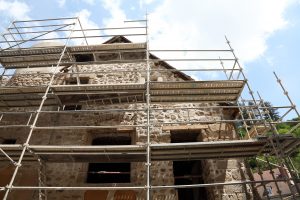What is repointing
Mortar is what holds bricks, stones and blocks together and as a result, it’s essential for maintaining the structural integrity of your property, as well as defending against the elements such as rain, dampness, wind and snow. If the mortar isn’t properly maintained, and is allowed to weaken and become exposed then the integrity of your property could be at risk and susceptible to worse problems, such as leaks and dampness.
That’s where repointing comes in. It’s the process of removing old mortar and replacing it with new, stronger mortar. It’s a brilliant way to fix any damage or wear and tear, with the added benefit of being able to improve or change the look of your property. It’s a service most commonly used for older buildings as brick mortar should last between 20 and 30 years.
If you want to learn more about repointing, read our blog here.
How do I know if my walls need repointing?
As mortar between houses erodes over time as a result of many things, such as bad weather, all homes will need repointing eventually – most lasting between 20 and 30 years, however, good quality pointing can last up to 50 years.
If you’re living in an older property and aren’t sure whether or not it needs repointing, there are some telltale signs that can give you an indication. For example, if the mortar between bricks feels soft or crumbles easily with little force, or if there are visual gaps, damaged brickwork or holes in the mortar then it’s probably time to start looking at booking repointing services.
To learn more about ways to tell if bricks need repointing, read our blog here.
The steps involved in repointing
Repointing sounds like an easy task, but it’s far from it and there are a few factors that make it harder.
- Firstly, it’s important to check the weather. This sounds obvious, but if it’s forecast to rain or if the temperature will be below freezing, then any pointing work should be postponed as it won’t set properly.
- Identify the areas that need repointing
- Prepare by cleaning the wall and making space. This is also where scaffolding should be installed if it is required.
- Remove current mortar from top to bottom, which is also known as raking out and involves scraping mortar from between bricks.
- Prepare the mortar so that it matches the existing colour or the new style while ensuring it is the correct consistency and strength.
- Spray the wall with water to stop the mortar from drying too quickly once it has been applied.
- Continue to apply mortar until all gaps and air pockets have been filled
- Remove excess mortar and clean bricks with a wire brush to smooth everything out
What affects the cost of repointing
There are a few variables that can affect the cost of repointing, such as:
The size of the job
The size of the job is obviously one of the biggest contributors to the cost as it will determine how long the work will take, how much scaffolding is needed and how many workers are required, as well as how much materials are needed.
Ease of access (use of scaffolding)
Depending on whether or not the project requires scaffolding, and spans across multiple floors will undoubtedly have an effect on the total cost, as either additional time will be required to put up and take down scaffolding, or budget will need to be added to the price to pay for a scaffolding contractor to install.
Raking out
When large areas of raking out is required, this can have an influence on the timeframe of the job which has an impact on the price of the job. Generally speaking, more work means more workers and more time which increases the price.
Cost of repointing a house
So, what are the numbers? Usually, jobs are priced either by square meter (m²), as a daily rate or by the project (or per property). For example, the average price in the UK to repoint a brick wall costs £50-60 per m². Using this as a general rule of thumb, the cost to repoint the front or side of a house is approximately £1,750 and the price to repoint a semi-detached property is £4,500.


